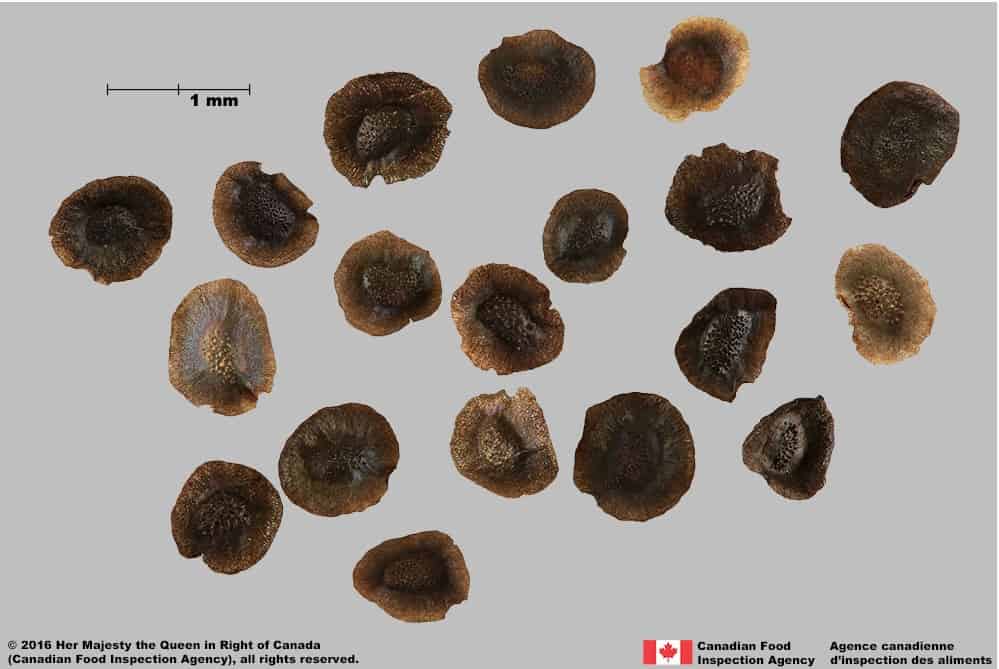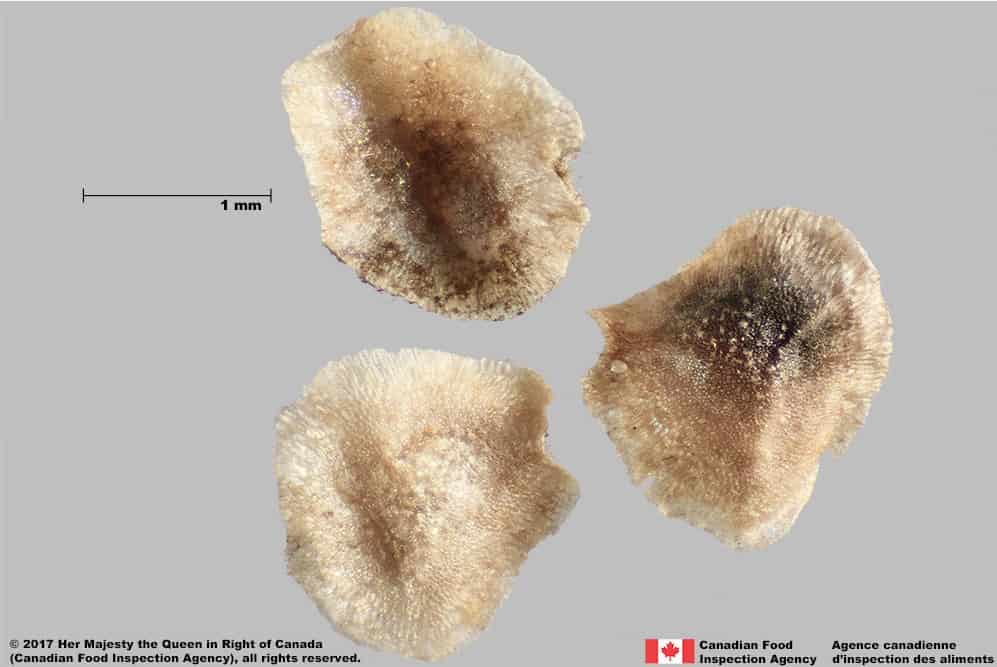Linaria vulgaris
Overview
Aperçu
Regulation :
Remarques Réglementation:
- CFIA Weed Seeds Order - Class 2: Primary Noxious Weed Seeds
- Quarantine lists of countries e.g. Mexico *may be updated without notice
- USA Federal Noxious Weed Seed List
Regulation Notes:
Distribution :
Répartition :
Native to Europe and temperate Asia (USDA-ARS 2022) and introduced in North America, Chile, South Africa, Australia and New Zealand (CABI 2022). In North America, it occurs in most of the United States, northern Mexico and Canada except for Nunavut (FNA 1993+; Brouillet et al. 2010+).
Habitat and Crop Association :
Habitat et Cultures Associées :
Cultivated fields, old fields, gardens, pastures, rangelands, shores, roadsides and other disturbed areas (Saner et al. 1995; Darbyshire 2003). L. vulgaris grows in a wide range of soils, but not in wet soils or deep shade (Saner et al. 1995).
It is a significant weed in perennial pastures, red fescue (Festuca rubra) forage crops, orchard crops and annual crops such as Triticum aestivum subsp aestivum (wheat), Hordeum vulgare subsp. vulgare (barley), Avena sativa (oats), Brassica napus var. napus (canola), and Pisum sativum (peas) (Saner et al. 1995; CABI 2022).
Economic Use, cultivation area, and Weed Association :
Utilisation économique, zone de culture et association de mauvaises herbes :
Duration of Life Cycle :
Durée du cycle vital:
Perennial
Dispersal Unit Type :
Type d’unité de dispersion :
Seed
General Information
RENSEIGNEMENTS GÉNÉRAUX
Linaria vulgaris was once grown as an ornamental, dye and medicinal plant (Saner et al. 1995). This species first appeared in Ontario and Quebec at the end of the 19th century and moved into the Prairie Provinces after 1920, through contaminated Medicago sativa (alfalfa) seed and as a garden plant (Saner et al. 1995).
This species can form fertile hybrids with L. dalmatica (named L. x hybrida Schur) and L. repens (named L. x sepium G. J. Allman) when grown in the same area; the plants and seeds exhibit features similar to L. vulgaris or intermediate between the 2 species (FNA 1993+; Saner et al. 1995).
L. vulgaris reproduces from both seed and adventitious roots (Saner et al. 1995). Seed production is variable, a range of 1500 – 30,000 seeds per plant have been estimated; 10-40 seeds per capsule in North America and 70-110 in Europe (Saner et al. 1995). Seeds are dispersed by water, ants, agricultural machinery and wind (Saner et al. 1995).
Seeds were found to have a low germination rate of under 10%, with most seeds remaining dormant until temperature treatments (Saner et al. 1995). Vegetative reproduction is important in this species, roots can produce new stems a few weeks after germination, with 90-100 new stems in the first year for each plant, increasing to 200-250 new stems by the second year (Saner et al. 1995). Plants may grow from a piece of root 1 cm long (CABI 2022).
.
Linaria vulgaris infestation (L.L. Berry, Bugwood.org)
Identification
Identification
-
Capsule
Size
- Capsule length : 5-10 mm; width : 3-8 mm (FNA 1993+)
Shape
- Capsule is round, oval or oblong shaped (FNA 1993+; Saner et al. 1995)
Surface Texture
- Capsule surface is smooth
Colour
- Capsule is straw-yellow coloured
Other Features
- Capsule opens at one end with toothed valves
-
Seed
Size
- Seed length*: 1.4 – 2.0 mm; width: 1.2 – 1.7 mm
*Note: minimum and maximum of 20 seeds in a normal range of this species using image measurement (ISMA 2020)
From additional sources:
- Seed diameter: 1.4– 2.1 mm (Saner et al. 1995)
- Seed length: 1.6 -2.5 mm; width: 1.5 – 2.3 mm (FNA 1993+)
Shape
- Seed round or oval shaped with a convex middle and a flat, thin wing around the outside of the seed, seed flattened in 3 dimensions
Surface Texture
- The convex centre of the seed is covered with warty tubercles
- The seed surface has ridged reticulation with shapes ranging from round near the seed centre to larger rectangular shapes on the wing
Colour
- Seeds are generally shiny black coloured, some are dark brown or dull grey
- Seeds generally have metallic brown highlights under the light of a microscope
- Immature seeds are dull straw yellow coloured
Other Features
Other than hilum
- A thin wing surrounds the seed, wing width*: 0.3 – 0.6 mm or 0.4 – 0.7 mm (FNA 1993+)
- Wing is ridged reticulate textured with small interspaces, visible under magnification (at least 40x)
- Grey coloured seeds were lighter and had a lower viability compared to black seeds (Saner et al. 1995)
*Note: minimum and maximum of 5 seeds in a normal range of this species using specimen measurement (ISMA 2020)

Yellow toadflax (Linaria vulgaris) seeds





-
Embryo
Size
- Embryo partially fills the seed
Shape
- Embryo is linear shaped in an axial position (Martin 1946)
Endosperm
- Endosperm is oily and whitish coloured
Identification Tips
CONSEILS POUR L’IDENTIFICATION
The seeds of Linaria species are generally black or dark brown coloured with a metallic reflection, small sized, and round or polygonal shaped. L. vulgaris seeds are round shaped with a convex centre and thin wing around the seed along with similar shaped species such as L. tristis or L. supina. The shape of the central area and the distribution of surface tubercles further distinguish L. vulgaris: it has a round central area with dense tubercles on both sides of the seed. Similar species have oval or C-shaped central areas with a different distribution of tubercles on the seed.

Yellow toadflax (Linaria vulgaris) seed





Additional Botany Information
AUTRES RENSEIGNEMENTS BOTANIQUES
Flowers/Inflorescence
- Flowers are generally yellow with an orange spot but can be white or light yellow coloured (FNA 1993+)
- Flower length: 27-32 mm (FNA 1993+)
- Flowers have a distinctive narrow cone-shaped spur that contains nectar, length: 11-15 mm (FNA 1993+)
- The timing of flowering varies with environmental conditions, and can continually flower from May-October (FNA 1993+; Saner et al. 1995)
Vegetative Features
- Colonies are formed by a creeping root system (Saner et al. 1995)
- Leaves are narrow and 24 – 55 mm in length with primarily alternate arrangement (Saner et al. 1995)
- Leaf length: 4 – 68 mm; width: 1 – 7 mm (FNA 1993+)

Linaria vulgaris flowers (William M. Ciesla, Forest Health Management International, Bugwood.org)




Similar Species
ESPÈCES SEMBLABLES
Similar species are based on a study of seed morphology of various species, and those with similar dispersal units are identified. The study is limited by physical specimen and literature availability at the time of examination, and possibly impacted by the subjectivity of the authors based on their knowledge and experience. Providing similar species information for seed identification is to make users aware of similarities that could possibly result in misidentification.
Linaria tristis (L.) Mill.
Linaria tristis seeds are a similar size or slightly larger as L. vulgaris (length*: 1.4 – 2.3 mm; width: 1.2 – 1.8 mm), they are generally smooth or with a few warty tubercles, but only on one side of the seed. The convex central area may be oval or C-shaped. L. vulgaris seeds have dense warty tubercles on both sides of the seed with a round convex centre.
*Note: minimum and maximum of 20 seeds in a normal range of this species using image measurement (ISMA 2020)
Linaria triornithophora (L.) Willd.
L. triornithophora is a garden plant, native to southwestern Europe, and has invaded disturbed areas in Oregon in the United States (FNA 1993+). The seeds are a similar size (diameter**: 1.7 – 2.0 mm) compared to L. vulgaris; they can be distinguished by a narrow wing around the outside, and small surface ridges compared to the wide wing and warty tubercles of L. vulgaris seeds.
**Note: minimum and maximum of 10 seeds in a normal range of this species using image measurement (ISMA 2020)
Linaria supina (L.) Chaz.
L. supina seeds may be smooth or have warty tubercles on both sides, the convex centre is C-shaped, compared to the round central area of L. vulgaris.
Click to select species
Cliquez pour sélectionner les espèces

Linaria tristis
Comparison Window
Fenêtre de comparaison
MAIN SPECIES
ESPÈCES PRINCIPALES
Linaria vulgaris

Linaria vulgaris
Plantaginaceae
Yellow toadflax (Linaria vulgaris) seeds
MAIN SPECIES
ESPÈCES PRINCIPALES
Linaria vulgaris

Linaria vulgaris
Plantaginaceae
Yellow toadflax (Linaria vulgaris) seeds
MAIN SPECIES
ESPÈCES PRINCIPALES
Linaria vulgaris

Linaria vulgaris
Plantaginaceae
Yellow toadflax (Linaria vulgaris) seed
MAIN SPECIES
ESPÈCES PRINCIPALES
Linaria vulgaris

Linaria vulgaris
Plantaginaceae
Yellow toadflax (Linaria vulgaris) seed
MAIN SPECIES
ESPÈCES PRINCIPALES
Linaria vulgaris

Linaria vulgaris
Plantaginaceae
Yellow toadflax (Linaria vulgaris) immature seeds
SIMILAR SPECIES
ESPÈCES SEMBLABLES
Linaria tristis

Linaria tristis
Plantaginaceae
Melancholy toadflax (Linaria tristis) seeds
SIMILAR SPECIES
ESPÈCES SEMBLABLES
Linaria tristis

Linaria tristis
Plantaginaceae
Melancholy toadflax (Linaria tristis) seeds
SIMILAR SPECIES
ESPÈCES SEMBLABLES
Linaria tristis

Linaria tristis
Plantaginaceae
Melancholy toadflax (Linaria tristis) seed
Need ID Help?
Besoin d’aide pour l’identification?
Reference(s)
Référence(s)
Brouillet, L., Coursol, F., Meades, S. J., Favreau, M., Anions, M., Bélisle, P. and Desmet, P. 2010+. VASCAN, the database of vascular plants of Canada. http://data.canadensys.net/vascan/ Accessed March 16, 2022.
Centre for Agriculture and Bioscience International (CABI). 2022. Invasive Species Compendium, CAB International, Wallingford, UK. https://www.cabidigitallibrary.org/journal/cabicompendium Accessed March 16, 2022.
Darbyshire, S. J. 2003. Inventory of Canadian Agricultural Weeds. Agriculture and Agri-Food Canada, Research Branch. Ottawa, ON.
Flora of North America (FNA) Editorial Committee, eds. 1993+. Flora of North America North of Mexico [Online]. 22+ vols. New York and Oxford. http://beta.floranorthamerica.org. Accessed December 29, 2022.
Global Biodiversity Information Facility (GBIF) Secretariat. 2022. https://doi.org/10.15468/39omei Accessed via https://www.gbif.org/species/5415020 Accessed December 29, 2022.
Government of Canada (GC). 2016. Canadian Weed Seeds Order. https://laws-lois.justice.gc.ca/eng/regulations/SOR-2016-93/page-2.html (English) https://laws-lois.justice.gc.ca/fra/reglements/DORS-2016-93/page-2.html (French)
International Seed Morphology Association (ISMA). 2020. Method for Seed Size Measurement. Version 1.0. ISMA Publication Guide.
Martin, A.C. 1946. The comparative internal morphology of seeds. The American Midland Naturalist 36: 513-660.
Plants of the World Online (POWO). 2022. Facilitated by the Royal Botanic Gardens, Kew. Published on the Internet; http://www.plantsoftheworldonline.org/ Accessed April 27, 2022.
Saner, M. A., Clements, D. A., Hall, M. R., Dohan, D. J. and Crompton, C. W. 1995. The biology of Canadian weeds. 105. Linaria vulgaris Mill. Canadian Journal of Plant Science 75: 525-537.
Tropicos.org. 2022. Missouri Botanical Garden. https://tropicos.org Accessed April 19, 2022.
U.S. Department of Agriculture-Agricultural Research Services (USDA-ARS). 2022. Germplasm Resources Information Network (GRIN), https://npgsweb.ars-grin.gov/gringlobal/taxon/taxonomysimple.aspx Accessed Accessed March 16, 2022.




